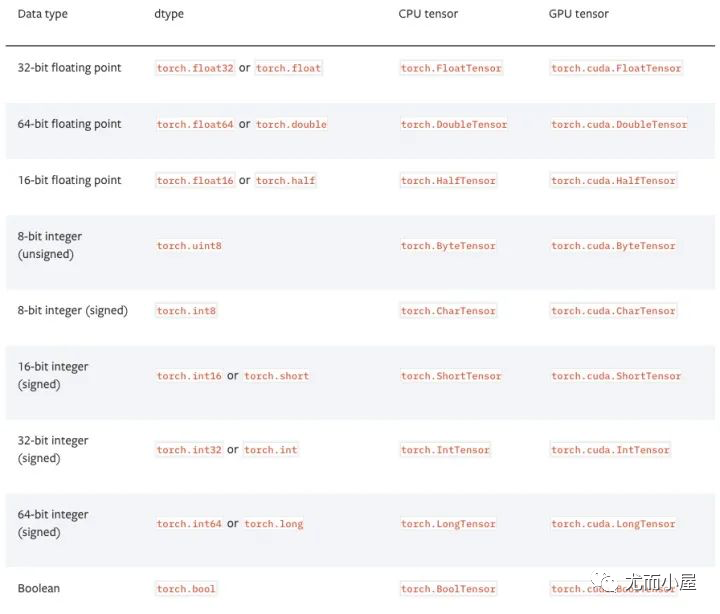本文是PyTorch常用代码段合集,涵盖基本配置、张量处理、模型定义与操作、数据处理、模型训练与测试等5个方面,还给出了多个值得注意的Tips,内容非常全面。
PyTorch最好的资料是官方文档。本文是PyTorch常用代码段,在参考资料[1](张皓:PyTorch Cookbook)的基础上做了一些修补,方便使用时查阅。
基本配置
导入包和版本查询
importtorch importtorch.nnasnn importtorchvision print(torch.__version__) print(torch.version.cuda) print(torch.backends.cudnn.version()) print(torch.cuda.get_device_name(0))
可复现性
在硬件设备(CPU、GPU)不同时,完全的可复现性无法保证,即使随机种子相同。但是,在同一个设备上,应该保证可复现性。具体做法是,在程序开始的时候固定torch的随机种子,同时也把numpy的随机种子固定。
np.random.seed(0) torch.manual_seed(0) torch.cuda.manual_seed_all(0) torch.backends.cudnn.deterministic=True torch.backends.cudnn.benchmark=False
显卡设置
如果只需要一张显卡
#Deviceconfiguration
device=torch.device('cuda'iftorch.cuda.is_available()else'cpu')
如果需要指定多张显卡,比如0,1号显卡。
importosos.environ['CUDA_VISIBLE_DEVICES']='0,1'
也可以在命令行运行代码时设置显卡:
CUDA_VISIBLE_DEVICES=0,1pythontrain.py
清除显存
torch.cuda.empty_cache()
也可以使用在命令行重置GPU的指令
nvidia-smi--gpu-reset-i[gpu_id]
张量(Tensor)处理
张量的数据类型
PyTorch有9种CPU张量类型和9种GPU张量类型。

张量基本信息
tensor=torch.randn(3,4,5)print(tensor.type())#数据类型print(tensor.size())#张量的shape,是个元组print(tensor.dim())#维度的数量
命名张量
张量命名是一个非常有用的方法,这样可以方便地使用维度的名字来做索引或其他操作,大大提高了可读性、易用性,防止出错。
#在PyTorch1.3之前,需要使用注释
#Tensor[N,C,H,W]
images=torch.randn(32,3,56,56)
images.sum(dim=1)
images.select(dim=1,index=0)
#PyTorch1.3之后
NCHW=[‘N’,‘C’,‘H’,‘W’]
images=torch.randn(32,3,56,56,names=NCHW)
images.sum('C')
images.select('C',index=0)
#也可以这么设置
tensor=torch.rand(3,4,1,2,names=('C','N','H','W'))
#使用align_to可以对维度方便地排序
tensor=tensor.align_to('N','C','H','W')
数据类型转换
#设置默认类型,pytorch中的FloatTensor远远快于DoubleTensor torch.set_default_tensor_type(torch.FloatTensor) #类型转换 tensor=tensor.cuda() tensor=tensor.cpu() tensor=tensor.float() tensor=tensor.long()
torch.Tensor与np.ndarray转换
除了CharTensor,其他所有CPU上的张量都支持转换为numpy格式然后再转换回来。
ndarray=tensor.cpu().numpy() tensor=torch.from_numpy(ndarray).float() tensor=torch.from_numpy(ndarray.copy()).float()#Ifndarrayhasnegativestride.
Torch.tensor与PIL.Image转换
#pytorch中的张量默认采用[N,C,H,W]的顺序,并且数据范围在[0,1],需要进行转置和规范化 #torch.Tensor->PIL.Image image=PIL.Image.fromarray(torch.clamp(tensor*255,min=0,max=255).byte().permute(1,2,0).cpu().numpy()) image=torchvision.transforms.functional.to_pil_image(tensor)#Equivalentlyway #PIL.Image->torch.Tensor path=r'./figure.jpg' tensor=torch.from_numpy(np.asarray(PIL.Image.open(path))).permute(2,0,1).float()/255 tensor=torchvision.transforms.functional.to_tensor(PIL.Image.open(path))#Equivalentlyway
np.ndarray与PIL.Image的转换
image=PIL.Image.fromarray(ndarray.astype(np.uint8)) ndarray=np.asarray(PIL.Image.open(path))
从只包含一个元素的张量中提取值
value=torch.rand(1).item()
张量形变
#在将卷积层输入全连接层的情况下通常需要对张量做形变处理, #相比torch.view,torch.reshape可以自动处理输入张量不连续的情况 tensor=torch.rand(2,3,4) shape=(6,4) tensor=torch.reshape(tensor,shape)
打乱顺序
tensor=tensor[torch.randperm(tensor.size(0))]#打乱第一个维度
水平翻转
#pytorch不支持tensor[::-1]这样的负步长操作,水平翻转可以通过张量索引实现 #假设张量的维度为[N,D,H,W]. tensor=tensor[:,:,:,torch.arange(tensor.size(3)-1,-1,-1).long()]
复制张量
#Operation|New/Sharedmemory|Stillincomputationgraph| tensor.clone()#|New|Yes| tensor.detach()#|Shared|No| tensor.detach.clone()()#|New|No|
张量拼接
''' 注意torch.cat和torch.stack的区别在于torch.cat沿着给定的维度拼接, 而torch.stack会新增一维。例如当参数是3个10x5的张量,torch.cat的结果是30x5的张量, 而torch.stack的结果是3x10x5的张量。 ''' tensor=torch.cat(list_of_tensors,dim=0) tensor=torch.stack(list_of_tensors,dim=0)
将整数标签转为one-hot编码
#pytorch的标记默认从0开始 tensor=torch.tensor([0,2,1,3]) N=tensor.size(0) num_classes=4 one_hot=torch.zeros(N,num_classes).long() one_hot.scatter_(dim=1,index=torch.unsqueeze(tensor,dim=1),src=torch.ones(N,num_classes).long())
得到非零元素
torch.nonzero(tensor)#indexofnon-zeroelements torch.nonzero(tensor==0)#indexofzeroelements torch.nonzero(tensor).size(0)#numberofnon-zeroelements torch.nonzero(tensor==0).size(0)#numberofzeroelements
判断两个张量相等
torch.allclose(tensor1,tensor2)#floattensor torch.equal(tensor1,tensor2)#inttensor
张量扩展
#Expandtensorofshape64*512toshape64*512*7*7. tensor=torch.rand(64,512) torch.reshape(tensor,(64,512,1,1)).expand(64,512,7,7)
矩阵乘法
#Matrixmultiplcation:(m*n)*(n*p)*->(m*p). result=torch.mm(tensor1,tensor2) #Batchmatrixmultiplication:(b*m*n)*(b*n*p)->(b*m*p) result=torch.bmm(tensor1,tensor2) #Element-wisemultiplication. result=tensor1*tensor2
计算两组数据之间的两两欧式距离
利用广播机制
dist=torch.sqrt(torch.sum((X1[:,None,:]-X2)**2,dim=2))
模型定义和操作
一个简单两层卷积网络的示例
#convolutionalneuralnetwork(2convolutionallayers)
classConvNet(nn.Module): def__init__(self,num_classes=10): super(ConvNet,self).__init__() self.layer1=nn.Sequential( nn.Conv2d(1,16,kernel_size=5,stride=1,padding=2), nn.BatchNorm2d(16), nn.ReLU(), nn.MaxPool2d(kernel_size=2,stride=2)) self.layer2=nn.Sequential( nn.Conv2d(16,32,kernel_size=5,stride=1,padding=2), nn.BatchNorm2d(32), nn.ReLU(), nn.MaxPool2d(kernel_size=2,stride=2)) self.fc=nn.Linear(7*7*32,num_classes) defforward(self,x): out=self.layer1(x) out=self.layer2(out) out=out.reshape(out.size(0),-1) out=self.fc(out) returnout model=ConvNet(num_classes).to(device)
卷积层的计算和展示可以用这个网站辅助。
双线性汇合(bilinear pooling)
X=torch.reshape(N,D,H*W)#AssumeXhasshapeN*D*H*W X=torch.bmm(X,torch.transpose(X,1,2))/(H*W)#Bilinearpooling assertX.size()==(N,D,D) X=torch.reshape(X,(N,D*D)) X=torch.sign(X)*torch.sqrt(torch.abs(X)+1e-5)#Signed-sqrtnormalization X=torch.nn.functional.normalize(X)#L2normalization
多卡同步 BN(Batch normalization)
当使用 torch.nn.DataParallel 将代码运行在多张 GPU 卡上时,PyTorch 的 BN 层默认操作是各卡上数据独立地计算均值和标准差,同步 BN 使用所有卡上的数据一起计算 BN 层的均值和标准差,缓解了当批量大小(batch size)比较小时对均值和标准差估计不准的情况,是在目标检测等任务中一个有效的提升性能的技巧。
sync_bn=torch.nn.SyncBatchNorm(num_features,
eps=1e-05, momentum=0.1, affine=True, track_running_stats=True)
将已有网络的所有BN层改为同步BN层
defconvertBNtoSyncBN(module,process_group=None):
'''RecursivelyreplaceallBNlayerstoSyncBNlayer. Args: module[torch.nn.Module].Network ''' ifisinstance(module,torch.nn.modules.batchnorm._BatchNorm): sync_bn=torch.nn.SyncBatchNorm(module.num_features,module.eps,module.momentum, module.affine,module.track_running_stats,process_group) sync_bn.running_mean=module.running_mean sync_bn.running_var=module.running_var ifmodule.affine: sync_bn.weight=module.weight.clone().detach() sync_bn.bias=module.bias.clone().detach() returnsync_bn else: forname,child_moduleinmodule.named_children(): setattr(module,name)=convert_syncbn_model(child_module,process_group=process_group)) returnmodule
类似 BN 滑动平均
如果要实现类似 BN 滑动平均的操作,在 forward 函数中要使用原地(inplace)操作给滑动平均赋值。
classBN(torch.nn.Module)
def__init__(self):
...
self.register_buffer('running_mean',torch.zeros(num_features))
defforward(self,X):
...
self.running_mean+=momentum*(current-self.running_mean)
计算模型整体参数量
num_parameters=sum(torch.numel(parameter)forparameterinmodel.parameters())
查看网络中的参数
可以通过model.state_dict()或者model.named_parameters()函数查看现在的全部可训练参数(包括通过继承得到的父类中的参数)
params=list(model.named_parameters())
(name,param)=params[28]
print(name)
print(param.grad)
print('-------------------------------------------------')
(name2,param2)=params[29]
print(name2)
print(param2.grad)
print('----------------------------------------------------')
(name1,param1)=params[30]
print(name1)
print(param1.grad)
模型可视化(使用pytorchviz)
szagoruyko/pytorchvizgithub.com
类似 Keras 的 model.summary() 输出模型信息,使用pytorch-summary
sksq96/pytorch-summarygithub.com
模型权重初始化
注意 model.modules() 和 model.children() 的区别:model.modules() 会迭代地遍历模型的所有子层,而 model.children() 只会遍历模型下的一层。
#Commonpractiseforinitialization. forlayerinmodel.modules(): ifisinstance(layer,torch.nn.Conv2d): torch.nn.init.kaiming_normal_(layer.weight,mode='fan_out', nonlinearity='relu') iflayer.biasisnotNone: torch.nn.init.constant_(layer.bias,val=0.0) elifisinstance(layer,torch.nn.BatchNorm2d): torch.nn.init.constant_(layer.weight,val=1.0) torch.nn.init.constant_(layer.bias,val=0.0) elifisinstance(layer,torch.nn.Linear): torch.nn.init.xavier_normal_(layer.weight) iflayer.biasisnotNone: torch.nn.init.constant_(layer.bias,val=0.0) #Initializationwithgiventensor. layer.weight=torch.nn.Parameter(tensor)
提取模型中的某一层
modules()会返回模型中所有模块的迭代器,它能够访问到最内层,比如self.layer1.conv1这个模块,还有一个与它们相对应的是name_children()属性以及named_modules(),这两个不仅会返回模块的迭代器,还会返回网络层的名字。
#取模型中的前两层 new_model=nn.Sequential(*list(model.children())[:2] #如果希望提取出模型中的所有卷积层,可以像下面这样操作: forlayerinmodel.named_modules(): ifisinstance(layer[1],nn.Conv2d): conv_model.add_module(layer[0],layer[1])
部分层使用预训练模型
注意如果保存的模型是 torch.nn.DataParallel,则当前的模型也需要是
model.load_state_dict(torch.load('model.pth'),strict=False)
将在 GPU 保存的模型加载到 CPU
model.load_state_dict(torch.load('model.pth',map_location='cpu'))
导入另一个模型的相同部分到新的模型
模型导入参数时,如果两个模型结构不一致,则直接导入参数会报错。用下面方法可以把另一个模型的相同的部分导入到新的模型中。
#model_new代表新的模型
#model_saved代表其他模型,比如用torch.load导入的已保存的模型
model_new_dict=model_new.state_dict()
model_common_dict={k:vfork,vinmodel_saved.items()ifkinmodel_new_dict.keys()}
model_new_dict.update(model_common_dict)
model_new.load_state_dict(model_new_dict)
数据处理
计算数据集的均值和标准差
importos importcv2 importnumpyasnp fromtorch.utils.dataimportDataset fromPILimportImage defcompute_mean_and_std(dataset): #输入PyTorch的dataset,输出均值和标准差 mean_r=0 mean_g=0 mean_b=0 forimg,_indataset: img=np.asarray(img)#changePILImagetonumpyarray mean_b+=np.mean(img[:,:,0]) mean_g+=np.mean(img[:,:,1]) mean_r+=np.mean(img[:,:,2]) mean_b/=len(dataset) mean_g/=len(dataset) mean_r/=len(dataset) diff_r=0 diff_g=0 diff_b=0 N=0 forimg,_indataset: img=np.asarray(img) diff_b+=np.sum(np.power(img[:,:,0]-mean_b,2)) diff_g+=np.sum(np.power(img[:,:,1]-mean_g,2)) diff_r+=np.sum(np.power(img[:,:,2]-mean_r,2)) N+=np.prod(img[:,:,0].shape) std_b=np.sqrt(diff_b/N) std_g=np.sqrt(diff_g/N) std_r=np.sqrt(diff_r/N) mean=(mean_b.item()/255.0,mean_g.item()/255.0,mean_r.item()/255.0) std=(std_b.item()/255.0,std_g.item()/255.0,std_r.item()/255.0) returnmean,std
得到视频数据基本信息
importcv2 video=cv2.VideoCapture(mp4_path) height=int(video.get(cv2.CAP_PROP_FRAME_HEIGHT)) width=int(video.get(cv2.CAP_PROP_FRAME_WIDTH)) num_frames=int(video.get(cv2.CAP_PROP_FRAME_COUNT)) fps=int(video.get(cv2.CAP_PROP_FPS)) video.release()
TSN 每段(segment)采样一帧视频
K=self._num_segments ifis_train: ifnum_frames>K: #Randomindexforeachsegment. frame_indices=torch.randint( high=num_frames//K,size=(K,),dtype=torch.long) frame_indices+=num_frames//K*torch.arange(K) else: frame_indices=torch.randint( high=num_frames,size=(K-num_frames,),dtype=torch.long) frame_indices=torch.sort(torch.cat(( torch.arange(num_frames),frame_indices)))[0] else: ifnum_frames>K: #Middleindexforeachsegment. frame_indices=num_frames/K//2 frame_indices+=num_frames//K*torch.arange(K) else: frame_indices=torch.sort(torch.cat(( torch.arange(num_frames),torch.arange(K-num_frames))))[0] assertframe_indices.size()==(K,) return[frame_indices[i]foriinrange(K)]
常用训练和验证数据预处理
其中 ToTensor 操作会将 PIL.Image 或形状为 H×W×D,数值范围为 [0, 255] 的 np.ndarray 转换为形状为 D×H×W,数值范围为 [0.0, 1.0] 的 torch.Tensor。
train_transform=torchvision.transforms.Compose([ torchvision.transforms.RandomResizedCrop(size=224, scale=(0.08,1.0)), torchvision.transforms.RandomHorizontalFlip(), torchvision.transforms.ToTensor(), torchvision.transforms.Normalize(mean=(0.485,0.456,0.406), std=(0.229,0.224,0.225)), ]) val_transform=torchvision.transforms.Compose([ torchvision.transforms.Resize(256), torchvision.transforms.CenterCrop(224), torchvision.transforms.ToTensor(), torchvision.transforms.Normalize(mean=(0.485,0.456,0.406), std=(0.229,0.224,0.225)), ])
模型训练和测试
分类模型训练代码
#Lossandoptimizer
criterion=nn.CrossEntropyLoss()
optimizer=torch.optim.Adam(model.parameters(),lr=learning_rate)
#Trainthemodel
total_step=len(train_loader)
forepochinrange(num_epochs):
fori,(images,labels)inenumerate(train_loader):
images=images.to(device)
labels=labels.to(device)
#Forwardpass
outputs=model(images)
loss=criterion(outputs,labels)
#Backwardandoptimizer
optimizer.zero_grad()
loss.backward()
optimizer.step()
if(i+1)%100==0:
print('Epoch:[{}/{}],Step:[{}/{}],Loss:{}'
.format(epoch+1,num_epochs,i+1,total_step,loss.item()))
分类模型测试代码
#Testthemodel
model.eval()#evalmode(batchnormusesmovingmean/variance
#insteadofmini-batchmean/variance)
withtorch.no_grad():
correct=0
total=0
forimages,labelsintest_loader:
images=images.to(device)
labels=labels.to(device)
outputs=model(images)
_,predicted=torch.max(outputs.data,1)
total+=labels.size(0)
correct+=(predicted==labels).sum().item()
print('Testaccuracyofthemodelonthe10000testimages:{}%'
.format(100*correct/total))
自定义loss
继承torch.nn.Module类写自己的loss。
classMyLoss(torch.nn.Moudle): def__init__(self): super(MyLoss,self).__init__() defforward(self,x,y): loss=torch.mean((x-y)**2) returnloss
标签平滑(label smoothing)
写一个label_smoothing.py的文件,然后在训练代码里引用,用LSR代替交叉熵损失即可。label_smoothing.py内容如下:
importtorch importtorch.nnasnn classLSR(nn.Module): def__init__(self,e=0.1,reduction='mean'): super().__init__() self.log_softmax=nn.LogSoftmax(dim=1) self.e=e self.reduction=reduction def_one_hot(self,labels,classes,value=1): """ Convertlabelstoonehotvectors Args: labels:torchtensorinformat[label1,label2,label3,...] classes:int,numberofclasses value:labelvalueinonehotvector,defaultto1 Returns: returnonehotformatlabelsinshape[batchsize,classes] """ one_hot=torch.zeros(labels.size(0),classes) #labelsandvalue_addedsizemustmatch labels=labels.view(labels.size(0),-1) value_added=torch.Tensor(labels.size(0),1).fill_(value) value_added=value_added.to(labels.device) one_hot=one_hot.to(labels.device) one_hot.scatter_add_(1,labels,value_added) returnone_hot def_smooth_label(self,target,length,smooth_factor): """converttargetstoone-hotformat,andsmooth them. Args: target:targetinformwith[label1,label2,label_batchsize] length:lengthofone-hotformat(numberofclasses) smooth_factor:smoothfactorforlabelsmooth Returns: smoothedlabelsinonehotformat """ one_hot=self._one_hot(target,length,value=1-smooth_factor) one_hot+=smooth_factor/(length-1) returnone_hot.to(target.device) defforward(self,x,target): ifx.size(0)!=target.size(0): raiseValueError('Expectedinputbatchsize({})tomatchtargetbatch_size({})' .format(x.size(0),target.size(0))) ifx.dim()< 2: raise ValueError('Expected input tensor to have least 2 dimensions(got {})' .format(x.size(0))) if x.dim() != 2: raise ValueError('Only 2 dimension tensor are implemented, (got {})' .format(x.size())) smoothed_target = self._smooth_label(target, x.size(1), self.e) x = self.log_softmax(x) loss = torch.sum(- x * smoothed_target, dim=1) if self.reduction == 'none': return loss elif self.reduction == 'sum': return torch.sum(loss) elif self.reduction == 'mean': return torch.mean(loss) else: raise ValueError('unrecognized option, expect reduction to be one of none, mean, sum')
或者直接在训练文件里做label smoothing
forimages,labelsintrain_loader: images,labels=images.cuda(),labels.cuda() N=labels.size(0) #Cisthenumberofclasses. smoothed_labels=torch.full(size=(N,C),fill_value=0.1/(C-1)).cuda() smoothed_labels.scatter_(dim=1,index=torch.unsqueeze(labels,dim=1),value=0.9) score=model(images) log_prob=torch.nn.functional.log_softmax(score,dim=1) loss=-torch.sum(log_prob*smoothed_labels)/N optimizer.zero_grad() loss.backward() optimizer.step()
Mixup训练
beta_distribution=torch.distributions.beta.Beta(alpha,alpha) forimages,labelsintrain_loader: images,labels=images.cuda(),labels.cuda() #Mixupimagesandlabels. lambda_=beta_distribution.sample([]).item() index=torch.randperm(images.size(0)).cuda() mixed_images=lambda_*images+(1-lambda_)*images[index,:] label_a,label_b=labels,labels[index] #Mixuploss. scores=model(mixed_images) loss=(lambda_*loss_function(scores,label_a) +(1-lambda_)*loss_function(scores,label_b)) optimizer.zero_grad() loss.backward() optimizer.step()
L1 正则化
l1_regularization=torch.nn.L1Loss(reduction='sum') loss=...#Standardcross-entropyloss forparaminmodel.parameters(): loss+=torch.sum(torch.abs(param)) loss.backward()
不对偏置项进行权重衰减(weight decay)
pytorch里的weight decay相当于l2正则
bias_list=(paramforname,paraminmodel.named_parameters()ifname[-4:]=='bias')
others_list=(paramforname,paraminmodel.named_parameters()ifname[-4:]!='bias')
parameters=[{'parameters':bias_list,'weight_decay':0},
{'parameters':others_list}]
optimizer=torch.optim.SGD(parameters,lr=1e-2,momentum=0.9,weight_decay=1e-4)
梯度裁剪(gradient clipping)
torch.nn.utils.clip_grad_norm_(model.parameters(),max_norm=20)
得到当前学习率
#Ifthereisonegloballearningrate(whichisthecommoncase). lr=next(iter(optimizer.param_groups))['lr'] #Iftherearemultiplelearningratesfordifferentlayers. all_lr=[] forparam_groupinoptimizer.param_groups: all_lr.append(param_group['lr'])
另一种方法,在一个batch训练代码里,当前的lr是optimizer.param_groups[0]['lr']
学习率衰减
#Reducelearningratewhenvalidationaccuarcyplateau. scheduler=torch.optim.lr_scheduler.ReduceLROnPlateau(optimizer,mode='max',patience=5,verbose=True) fortinrange(0,80): train(...) val(...) scheduler.step(val_acc) #Cosineannealinglearningrate. scheduler=torch.optim.lr_scheduler.CosineAnnealingLR(optimizer,T_max=80) #Reducelearningrateby10atgivenepochs. scheduler=torch.optim.lr_scheduler.MultiStepLR(optimizer,milestones=[50,70],gamma=0.1) fortinrange(0,80): scheduler.step() train(...) val(...) #Learningratewarmupby10epochs. scheduler=torch.optim.lr_scheduler.LambdaLR(optimizer,lr_lambda=lambdat:t/10) fortinrange(0,10): scheduler.step() train(...) val(...)
优化器链式更新
从1.4版本开始,torch.optim.lr_scheduler 支持链式更新(chaining),即用户可以定义两个 schedulers,并交替在训练中使用。
importtorch fromtorch.optimimportSGD fromtorch.optim.lr_schedulerimportExponentialLR,StepLR model=[torch.nn.Parameter(torch.randn(2,2,requires_grad=True))] optimizer=SGD(model,0.1) scheduler1=ExponentialLR(optimizer,gamma=0.9) scheduler2=StepLR(optimizer,step_size=3,gamma=0.1) forepochinrange(4): print(epoch,scheduler2.get_last_lr()[0]) optimizer.step() scheduler1.step() scheduler2.step()
模型训练可视化
PyTorch可以使用tensorboard来可视化训练过程。
安装和运行TensorBoard。
pipinstalltensorboard tensorboard--logdir=runs
使用SummaryWriter类来收集和可视化相应的数据,放了方便查看,可以使用不同的文件夹,比如'Loss/train'和'Loss/test'。
fromtorch.utils.tensorboardimportSummaryWriter
importnumpyasnp
writer=SummaryWriter()
forn_iterinrange(100):
writer.add_scalar('Loss/train',np.random.random(),n_iter)
writer.add_scalar('Loss/test',np.random.random(),n_iter)
writer.add_scalar('Accuracy/train',np.random.random(),n_iter)
writer.add_scalar('Accuracy/test',np.random.random(),n_iter)
保存与加载断点
注意为了能够恢复训练,我们需要同时保存模型和优化器的状态,以及当前的训练轮数。
start_epoch=0 #Loadcheckpoint. ifresume:#resume为参数,第一次训练时设为0,中断再训练时设为1 model_path=os.path.join('model','best_checkpoint.pth.tar') assertos.path.isfile(model_path) checkpoint=torch.load(model_path) best_acc=checkpoint['best_acc'] start_epoch=checkpoint['epoch'] model.load_state_dict(checkpoint['model']) optimizer.load_state_dict(checkpoint['optimizer']) print('Loadcheckpointatepoch{}.'.format(start_epoch)) print('Bestaccuracysofar{}.'.format(best_acc)) #Trainthemodel forepochinrange(start_epoch,num_epochs): ... #Testthemodel ... #savecheckpoint is_best=current_acc>best_acc best_acc=max(current_acc,best_acc) checkpoint={ 'best_acc':best_acc, 'epoch':epoch+1, 'model':model.state_dict(), 'optimizer':optimizer.state_dict(), } model_path=os.path.join('model','checkpoint.pth.tar') best_model_path=os.path.join('model','best_checkpoint.pth.tar') torch.save(checkpoint,model_path) ifis_best: shutil.copy(model_path,best_model_path)
提取 ImageNet 预训练模型某层的卷积特征
#VGG-16relu5-3feature. model=torchvision.models.vgg16(pretrained=True).features[:-1] #VGG-16pool5feature. model=torchvision.models.vgg16(pretrained=True).features #VGG-16fc7feature. model=torchvision.models.vgg16(pretrained=True) model.classifier=torch.nn.Sequential(*list(model.classifier.children())[:-3]) #ResNetGAPfeature. model=torchvision.models.resnet18(pretrained=True) model=torch.nn.Sequential(collections.OrderedDict( list(model.named_children())[:-1])) withtorch.no_grad(): model.eval() conv_representation=model(image)
提取 ImageNet 预训练模型多层的卷积特征
classFeatureExtractor(torch.nn.Module): """Helperclasstoextractseveralconvolutionfeaturesfromthegiven pre-trainedmodel. Attributes: _model,torch.nn.Module. _layers_to_extract,listorset Example: >>>model=torchvision.models.resnet152(pretrained=True) >>>model=torch.nn.Sequential(collections.OrderedDict( list(model.named_children())[:-1])) >>>conv_representation=FeatureExtractor( pretrained_model=model, layers_to_extract={'layer1','layer2','layer3','layer4'})(image) """ def__init__(self,pretrained_model,layers_to_extract): torch.nn.Module.__init__(self) self._model=pretrained_model self._model.eval() self._layers_to_extract=set(layers_to_extract) defforward(self,x): withtorch.no_grad(): conv_representation=[] forname,layerinself._model.named_children(): x=layer(x) ifnameinself._layers_to_extract: conv_representation.append(x) returnconv_representation
微调全连接层
model=torchvision.models.resnet18(pretrained=True) forparaminmodel.parameters(): param.requires_grad=False model.fc=nn.Linear(512,100)#Replacethelastfclayer optimizer=torch.optim.SGD(model.fc.parameters(),lr=1e-2,momentum=0.9,weight_decay=1e-4)
以较大学习率微调全连接层,较小学习率微调卷积层
model=torchvision.models.resnet18(pretrained=True)
finetuned_parameters=list(map(id,model.fc.parameters()))
conv_parameters=(pforpinmodel.parameters()ifid(p)notinfinetuned_parameters)
parameters=[{'params':conv_parameters,'lr':1e-3},
{'params':model.fc.parameters()}]
optimizer=torch.optim.SGD(parameters,lr=1e-2,momentum=0.9,weight_decay=1e-4)
其他注意事项
不要使用太大的线性层。因为nn.Linear(m,n)使用的是的内存,线性层太大很容易超出现有显存。
不要在太长的序列上使用RNN。因为RNN反向传播使用的是BPTT算法,其需要的内存和输入序列的长度呈线性关系。
model(x) 前用 model.train() 和 model.eval() 切换网络状态。
不需要计算梯度的代码块用 with torch.no_grad() 包含起来。
model.eval() 和 torch.no_grad() 的区别在于,model.eval() 是将网络切换为测试状态,例如 BN 和dropout在训练和测试阶段使用不同的计算方法。torch.no_grad() 是关闭 PyTorch 张量的自动求导机制,以减少存储使用和加速计算,得到的结果无法进行 loss.backward()。
model.zero_grad()会把整个模型的参数的梯度都归零, 而optimizer.zero_grad()只会把传入其中的参数的梯度归零.
torch.nn.CrossEntropyLoss 的输入不需要经过 Softmax。torch.nn.CrossEntropyLoss 等价于 torch.nn.functional.log_softmax + torch.nn.NLLLoss。
loss.backward() 前用 optimizer.zero_grad() 清除累积梯度。
torch.utils.data.DataLoader 中尽量设置 pin_memory=True,对特别小的数据集如 MNIST 设置 pin_memory=False 反而更快一些。num_workers 的设置需要在实验中找到最快的取值。
用 del 及时删除不用的中间变量,节约 GPU 存储。使用 inplace 操作可节约 GPU 存储,如:
x=torch.nn.functional.relu(x,inplace=True)
减少 CPU 和 GPU 之间的数据传输。例如如果你想知道一个 epoch 中每个 mini-batch 的 loss 和准确率,先将它们累积在 GPU 中等一个 epoch 结束之后一起传输回 CPU 会比每个 mini-batch 都进行一次 GPU 到 CPU 的传输更快。
使用半精度浮点数 half() 会有一定的速度提升,具体效率依赖于 GPU 型号。需要小心数值精度过低带来的稳定性问题。
时常使用 assert tensor.size() == (N, D, H, W) 作为调试手段,确保张量维度和你设想中一致。
除了标记 y 外,尽量少使用一维张量,使用 n*1 的二维张量代替,可以避免一些意想不到的一维张量计算结果。
统计代码各部分耗时:
withtorch.autograd.profiler.profile(enabled=True,use_cuda=False)asprofile:
...print(profile)#或者在命令行运行python-mtorch.utils.bottleneckmain.py
使用TorchSnooper来调试PyTorch代码,程序在执行的时候,就会自动 print 出来每一行的执行结果的 tensor 的形状、数据类型、设备、是否需要梯度的信息。
#pipinstalltorchsnooper importtorchsnooper#对于函数,使用修饰器@torchsnooper.snoop() #如果不是函数,使用 with 语句来激活 TorchSnooper,把训练的那个循环装进 with 语句中去。 withtorchsnooper.snoop(): 原本的代码
https://github.com/zasdfgbnm/TorchSnoopergithub.com
模型可解释性,使用captum库:https://captum.ai/captum.ai
审核编辑:黄飞
-
cpu
+关注
关注
68文章
10901浏览量
212886 -
gpu
+关注
关注
28文章
4768浏览量
129317 -
函数
+关注
关注
3文章
4345浏览量
62931 -
pytorch
+关注
关注
2文章
808浏览量
13346
原文标题:PyTorch高频代码段集锦!
文章出处:【微信号:vision263com,微信公众号:新机器视觉】欢迎添加关注!文章转载请注明出处。
发布评论请先 登录
相关推荐
Verilog HDL详细资料合集!
智能家居合集资料
工程测试技术的详细中文合集资料(免费下载)

使用51单片机设计的智能小车程序代码合集资料免费下载
VB.NET的常用命名空间和类介绍和VB的完美代码库资料合集免费

如何进行编程可以减少程序的bug?单片机技巧合集资料下载





 PyTorch常用代码段合集资料分享
PyTorch常用代码段合集资料分享













评论